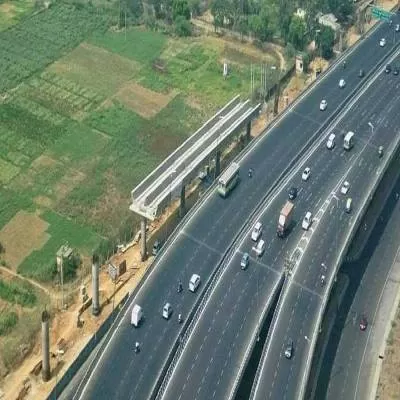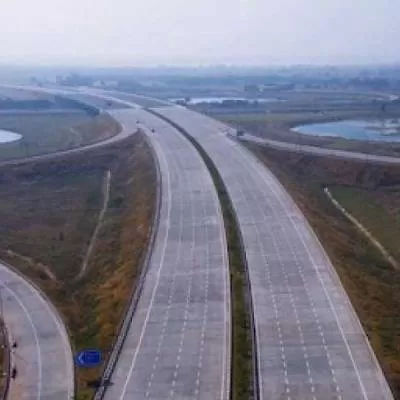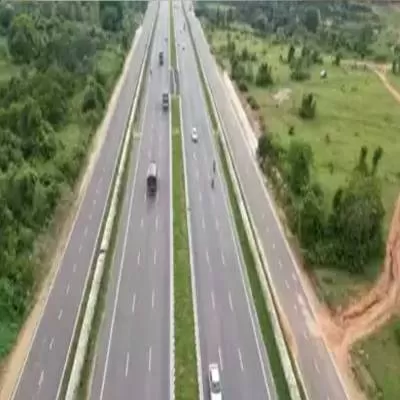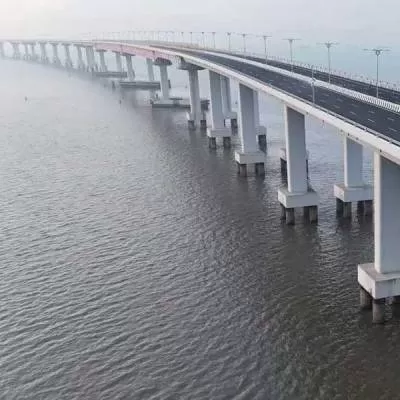- Home
- Infrastructure Transport
- ROADS & HIGHWAYS
- Laying the Foundation

Laying the Foundation
India has the second largest road network in the world, spanning a total of 4.87 million km. Roads in India transport over 60 per cent of all goods and 85 per cent of total passenger traffic. Cognisant of the need to create an adequate road network to cater to the increased traffic and movement of goods, the Indian Government has earmarked 20 per cent of the investment of $1 trillion reserved for infrastructure during the Twelfth Five-Year Plan (2012-17) to develop the country´s roads. The value of roads and bridges infrastructure in the country is projected to grow at a CAGR of 17.4 per cent over FY2012-17 from $6.9 billion in 2009 to touch $19.2 billion by 2017.
The private sector has emerged as a key player in the development of road infrastructure in India. The government´s policy to increase private sector participation has proved to be a boon for the infrastructure industry, with a large number of private players entering the business through the public-private partnership (PPP) model. However, this uncontrolled influx brought with it its fair share of trouble. The fanatical bidding by some inexperienced players, coupled with lack of land availability in the projects, led to cash flow issues. The situation was further compounded by a slowing economy and a banking industry that was slowly growing averse to the sector, owing to the mounting NPAs on its books. This has had a cascading effect on the entire industry, especially on the roads sector, with many projects being abandoned after having been awarded.
Strategic focus
This lull of around two to three years forced the government to rethink its strategies, as the slowing infrastructure sector was beginning to affect growth plans. To start with, the ministry shifted its focus from PPP to EPC, in order to address the impending cash flow issues in the sector. The newly formed government at the Centre, having realised the issues plaguing the sector, kicked-off its functioning with a series of consultation processes with stakeholders and players. The government wanted to understand the issues and address them, in order to improve the delivery of projects on the ground, and to bring about a resurgence in the lagging sector. Although the intent of the government at the Centre has been very clear, these measures are yet to deliver the desired impact on the ground fully. The government is working on policies to attract significant investor interest and plans to develop a total of 66,117 km of roads under different programmes such as National Highways Development Project (NHDP), Special Accelerated Road Development Programme in North East (SARDP-NE) and Improvement of Road Connectivity in Left Wing Extremism Affected Areas, and has set an objective of building 30 km of road a day from 2016.
Money matters During the next five years, investment through PPP is expected to be $31 billion. With the government permitting 100 per cent foreign direct investment (FDI) in the roads sector, several foreign companies have formed partnerships with Indian players to capitalise on the sector´s growth. The construction of highways had reached an all-time high of 6,029 km during FY2015-16, and the increased pace of construction is expected to continue in the coming years. The financial outlay for road transport and highways grew at a CAGR of 12.5 per cent in the period FY2010-2016. The budget outlay for 2016-17 stepped up budgetary support for road transport and highways to Rs 97,000 crore ($14.45 billion).
The government has further unveiled investments plans totalling Rs 10 trillion ($148.24 billion) in the highways and shipping sectors by 2019.
This sector runs on four wheels - the ministry, financial institutions, private players (concessionaires and contractors), and the public. In order to achieve the milestones and bring about the much required resurgence in the roads sector, it is imperative that all the wheels move forward towards a common objective in a controlled and coordinated manner, in order to set the nation rolling back on the path of growth. This metamorphosis should also bring about a greater sense of maturity among these four drivers of the sector, leaving this space richer in terms of experience and capability.
About the author:
Mukund Sapre is CEO, Infrastructure Leasing & Financial Services (IL&FS) and IL&FS Engineering and Construction Company Ltd (IECCL); Executive Director, IL&FS Transportation Networks Ltd (ITNL) and Managing Director, Elsamex SA. With close to 36 years of experience spanning the width of the sector across verticals, Sapre is vigorously engaged in changing the face of the transportation sector in India, and has been a key member of various groups to implement PPP projects.
Master Plan
A total of 599 highway projects covering around 12,903 km of national highways have been sanctioned since May 2014, with an expenditure of Rs 108,000 crore ($16 billion). Some of the major developments and key initiatives taken by the government to provide the necessary impetus to the sector are as follows:
- The Government of India plans to introduce a new framework on renegotiation of public-private partnership (PPP) contracts, which will allow renegotiations based on sector-specific issues, especially for national highways and ports, and provide greater flexibility to the parties involved.
- The Ministry of Road Transport and Highways plans to set up Land Acquisition (LA) cells across the country, which will work towards resolving issues related to land acquisition and ensure speedy compensation disbursal by the state governments.
- The Cabinet Committee on Economic Affairs (CCEA) has approved a hybrid annuity model for implementing highway projects, which adopts a more rational approach to allocation of risks between the government and the private developer, and is hence expected to revive highway projects construction in India. Around 35 projects have already been put to bid under this format, which has been well received by the sector participants.
- The Centre has signed an agreement for the third and last tranche of a $273-million loan, out of the total $800-million loan agreement with the Asian Development Bank (ADB), for constructing 6,000 km of all-weather rural roads in Assam, Chhattisgarh, Madhya Pradesh, Odisha and West Bengal, by December 2017.
- The CCEA has approved a one-time fund infusion in road projects, which are at least 50 per cent complete till November 2014, but this move has not progressed further because of shortage of funds.
- Minister for Roads, Transport and Highways Nitin Gadkari has announced that the government is planning a compensation policy for road sector developers, which will seek to compensate companies for any delays related to clearance for road projects. This will help in speedy completion and settlement of claims for most projects stuck in arbitration. Half of NHAI´s 600 projects awarded in the last 10 years are stuck in disputes with 123 cases for a claim amount of Rs 25,000 crore pending before the arbitration tribunal.
- The Indian Government plans to set up a finance corporation with an amount of Rs 1 trillion ($14.82 billion), in collaboration with Japanese investors, to fund projects in the roads segment.
- The Government of India plans to award 100 highway projects under the PPP mode in 2016, with expectations that recent amendments in regulations would revive investor sentiments in PPP projects in the infrastructure sector.
- The CCEA has permitted 100 per cent equity divestment by private developers after two years of construction completion for all BOT projects, irrespective of the year of award of the project.
To bring about the much required resurgence in the roads sector, the ministry, financial institutions, private players and the public should move forward in a coordinated manner, says MUKUND SAPRE. India has the second largest road network in the world, spanning a total of 4.87 million km. Roads in India transport over 60 per cent of all goods and 85 per cent of total passenger traffic. Cognisant of the need to create an adequate road network to cater to the increased traffic and movement of goods, the Indian Government has earmarked 20 per cent of the investment of $1 trillion reserved for infrastructure during the Twelfth Five-Year Plan (2012-17) to develop the country´s roads. The value of roads and bridges infrastructure in the country is projected to grow at a CAGR of 17.4 per cent over FY2012-17 from $6.9 billion in 2009 to touch $19.2 billion by 2017. The private sector has emerged as a key player in the development of road infrastructure in India. The government´s policy to increase private sector participation has proved to be a boon for the infrastructure industry, with a large number of private players entering the business through the public-private partnership (PPP) model. However, this uncontrolled influx brought with it its fair share of trouble. The fanatical bidding by some inexperienced players, coupled with lack of land availability in the projects, led to cash flow issues. The situation was further compounded by a slowing economy and a banking industry that was slowly growing averse to the sector, owing to the mounting NPAs on its books. This has had a cascading effect on the entire industry, especially on the roads sector, with many projects being abandoned after having been awarded. Strategic focus This lull of around two to three years forced the government to rethink its strategies, as the slowing infrastructure sector was beginning to affect growth plans. To start with, the ministry shifted its focus from PPP to EPC, in order to address the impending cash flow issues in the sector. The newly formed government at the Centre, having realised the issues plaguing the sector, kicked-off its functioning with a series of consultation processes with stakeholders and players. The government wanted to understand the issues and address them, in order to improve the delivery of projects on the ground, and to bring about a resurgence in the lagging sector. Although the intent of the government at the Centre has been very clear, these measures are yet to deliver the desired impact on the ground fully. The government is working on policies to attract significant investor interest and plans to develop a total of 66,117 km of roads under different programmes such as National Highways Development Project (NHDP), Special Accelerated Road Development Programme in North East (SARDP-NE) and Improvement of Road Connectivity in Left Wing Extremism Affected Areas, and has set an objective of building 30 km of road a day from 2016. Money matters During the next five years, investment through PPP is expected to be $31 billion. With the government permitting 100 per cent foreign direct investment (FDI) in the roads sector, several foreign companies have formed partnerships with Indian players to capitalise on the sector´s growth. The construction of highways had reached an all-time high of 6,029 km during FY2015-16, and the increased pace of construction is expected to continue in the coming years. The financial outlay for road transport and highways grew at a CAGR of 12.5 per cent in the period FY2010-2016. The budget outlay for 2016-17 stepped up budgetary support for road transport and highways to Rs 97,000 crore ($14.45 billion). The government has further unveiled investments plans totalling Rs 10 trillion ($148.24 billion) in the highways and shipping sectors by 2019. This sector runs on four wheels - the ministry, financial institutions, private players (concessionaires and contractors), and the public. In order to achieve the milestones and bring about the much required resurgence in the roads sector, it is imperative that all the wheels move forward towards a common objective in a controlled and coordinated manner, in order to set the nation rolling back on the path of growth. This metamorphosis should also bring about a greater sense of maturity among these four drivers of the sector, leaving this space richer in terms of experience and capability. About the author: Mukund Sapre is CEO, Infrastructure Leasing & Financial Services (IL&FS) and IL&FS Engineering and Construction Company Ltd (IECCL); Executive Director, IL&FS Transportation Networks Ltd (ITNL) and Managing Director, Elsamex SA. With close to 36 years of experience spanning the width of the sector across verticals, Sapre is vigorously engaged in changing the face of the transportation sector in India, and has been a key member of various groups to implement PPP projects. Master Plan A total of 599 highway projects covering around 12,903 km of national highways have been sanctioned since May 2014, with an expenditure of Rs 108,000 crore ($16 billion). Some of the major developments and key initiatives taken by the government to provide the necessary impetus to the sector are as follows: The Government of India plans to introduce a new framework on renegotiation of public-private partnership (PPP) contracts, which will allow renegotiations based on sector-specific issues, especially for national highways and ports, and provide greater flexibility to the parties involved. The Ministry of Road Transport and Highways plans to set up Land Acquisition (LA) cells across the country, which will work towards resolving issues related to land acquisition and ensure speedy compensation disbursal by the state governments. The Cabinet Committee on Economic Affairs (CCEA) has approved a hybrid annuity model for implementing highway projects, which adopts a more rational approach to allocation of risks between the government and the private developer, and is hence expected to revive highway projects construction in India. Around 35 projects have already been put to bid under this format, which has been well received by the sector participants. The Centre has signed an agreement for the third and last tranche of a $273-million loan, out of the total $800-million loan agreement with the Asian Development Bank (ADB), for constructing 6,000 km of all-weather rural roads in Assam, Chhattisgarh, Madhya Pradesh, Odisha and West Bengal, by December 2017. The CCEA has approved a one-time fund infusion in road projects, which are at least 50 per cent complete till November 2014, but this move has not progressed further because of shortage of funds. Minister for Roads, Transport and Highways Nitin Gadkari has announced that the government is planning a compensation policy for road sector developers, which will seek to compensate companies for any delays related to clearance for road projects. This will help in speedy completion and settlement of claims for most projects stuck in arbitration. Half of NHAI´s 600 projects awarded in the last 10 years are stuck in disputes with 123 cases for a claim amount of Rs 25,000 crore pending before the arbitration tribunal. The Indian Government plans to set up a finance corporation with an amount of Rs 1 trillion ($14.82 billion), in collaboration with Japanese investors, to fund projects in the roads segment. The Government of India plans to award 100 highway projects under the PPP mode in 2016, with expectations that recent amendments in regulations would revive investor sentiments in PPP projects in the infrastructure sector. The CCEA has permitted 100 per cent equity divestment by private developers after two years of construction completion for all BOT projects, irrespective of the year of award of the project.




















